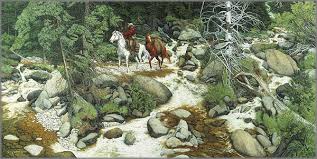The history of camouflage art is based in survival, but it has since evolved to mean many things.
Up until around WWI many armies and navies were dressed in the bright uniforms of their profession. This included items such as red jackets and white gloves [1]. Fighting in this period of history was undergoing a technical and strategic transformation in terms of trench and aerial warfare, and conspicuous uniforms were killing soldiers.
Enter Camouflage. From the French word camoufler, “to disguise” [1]. Here artists were employed by governments to help and create uniforms and painting schemes that would save lives. Pioneers include Grant Wood and Jacques Villon. The art of camouflage was taken seriously: “Abbott Thayer, whose 1909 book Concealing Coloration in the Animal Kingdom became required reading for the U.S. Army’s newly launched unit of camoufleurs” [1].

[5]. Soldiers in varying uniforms throughout history. Note the different kinds of colors and patterns
Not only uniforms, but also ships were being disguised: “Norman Wilkinson, a British naval officer and painter, suggested a scheme that came to be known as Dazzle or Razzle Dazzle painting. Wilkinson believed that breaking up a ship’s silhouette with brightly contrasting geometric designs would make it harder for U-boat captains to determine the ship’s course” [2].

[2]. Credit: Jim and Jaime Richter. A ship painted in Razzle Dazzle
This didn’t work so well, as you can imagine (does that look like a not-ship to you you?) But this kind of painting also inspired fine artists like this design of Fiat Strada painted in dazzle by Patricia van Lubeck, 1990 [2]:

[2]. A car painted in Razzle Dazzle by Patricia van Lubeck, 1990
Much later, after the war, different kinds of camouflage art, not related to war (my favorite) emerged in other art forms. Bev Doolittle is a famous western artist who painted the famous “Pintos” in 1979 [3].

[6]. “Pintos” by Bev Doolittle, 1979
There were other camouflage artists that focused on a more realism approach, such as Liu Bolin, known as “The Invisible Man”. His artwork is more political, conveying (perhaps) and individual blending into or hiding in society for various reasons [4].


[7]. What is he trying to say about the Chinese police? About the Chinese people? About Graffiti? By Liu Bolin
More recently there have been camouflage artistry incorporated in video form such as these clips you may remember:
This one is more like re-verse camouflage :
(By Johannes Stötter
(Painting done by Emma Huck)
Sources
- http://content.time.com/time/nation/article/0,8599,1906083,00.html
- http://www.darkroastedblend.com/2007/11/modernist-art-in-camouflage.html
- http://www.greenwichworkshop.com/doolittle/
- http://www.kleinsungallery.com/artists/liu-bolin
- https://www.rallypoint.com/topics/uniforms
- http://www.artcountrycanada.com/doolittle.htm
- http://www.boredpanda.com/liu-bolin-invisible-man-camouflage-art/


3 Comments. Leave new
When I hear the word camouflage, I immediately think of hunting gear. Then I remember the scene in “Bambi” when his mother dies. Camouflage tends to carry a negative connotation with me. The cover photo for your post made me look twice, since I wouldn’t immediately associate camouflage with art. I’m glad I have a new image in my mind when I next think of camouflage.
I really like how you used the historical facts of camouflage to draw the reader in and give them a good basis to judge the topic by. Why is it that non-war camouflage is your favorite aesthetic? What does it do differently for you?
I always wondered why camouflage looked certain ways, whether its the army, navy or the airforce. It all makes sense now that its some kind of a technique and painting schemes to trick the enemy. Thanks for posting such useful info.